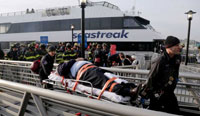
Photo: AP / AP
The captain of the Seastreak Wall Street ferry which hit the Pier 11 in New York yesterday morning, injuring more than 70 passengers, told investigators that the ferry suffered a mechanical failure. Captain Jason Reimer said that the engines would not go into reverse when he attempted to dock the ferry.
When it was built in 2003, the ferry was powered by four diesel engines powering four water jets, giving the ferry a speed in excess of 38 knots. The ducted water jets also made the ferry highly maneuverable, though not necessarily very energy efficient. In August of this year the ferry was taken out of service for a major refit of its propulsion system. The four engines were replaced by two and the water jets were replaced by controllable pitch propellers and rudders. The new propulsion system made the ferry 15 tons lighter, 20% more fuel efficient and cut per-passenger CO2 emissions by half.
Unfortunately, the new propulsion system made the ferry less maneuverable than it was with the older waterjet system. There were also reports of problems in the new gear that were being worked out. The National Transportation Safety Board investigators will, no doubt, be looking closely at the new engines and propeller control system.

Judge Marilyn Millian of the People’s Court would ask with Her toothy Grin: How did that money saving Ship-Alt work out for you!
It’s funny: they went from a Jet Ski, Wave Runner, PBR, design to propellers: on paper the Higher Specific Speed, and higher efficiency of a Propeller vs a Centrifugal Pump is a no brainer. However, the Naval Architects who designed The Sea Streak should have incorporated this design feature into the vessels original configuration.